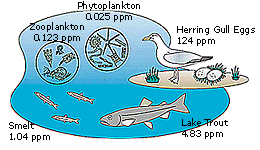PCB's (Polychlorinated Biphenyls)
How dangerous are PCB’s?
PCB’s are toxic to humans and but also enter marine food chains causing significant harm to marine mammals such as seals and dolphins.
 PCBs and marine food chains:
PCBs and marine food chains:
- Accumulation in the lower trophic levels such as plankton, crustacea. The PCBs are in sediments and can also form a thin layer floating on the water surface. The PCB’s are NOT ingested but coat the organisms.
- As these organisms are eaten, the PCB’s accumulate in top carnivores (marine mammals) by bio- magnification. The PCB’s are stored in fatty blubber (there are high levels of fat in these marine animals which are used for insulation and streamlining). Bio-accumulation in blubber may be as high as ten million fold.
- Fish eating birds provide a good monitor for PCB accumulation. Since most factories using PCBs were located near rivers, coasts and estuaries, PCBs can easily enter coastal marine environments.
- Analysis of sea-birds off the UK coast (razorbills and puffins ) in 1984 showed PCB levels to be 150 ppm (parts per million).
- Some individuals showed levels of 900ppm. Up to 60 different PCBs were often detected in one individual. Herring gulls also accumulated PCBs even though they are usually scavengers.
Toxic effects on humans and animals -
- If ingested, PCB’s can cause:
 More detail
More detail - Cancer
- Damage to the immune, reproductive, nervous and hormonal systems
- In 1968, 1300 Japanese developed skin lesions, liver and kidney damage after eating rice contaminated with PCBs leaked from a heat exchanger.
- 1973, 250kg accidentally added to feedstuffs in America, resulted in destruction of 290,000 cattle, 6000 pigs, 1500 sheep and 1.5 million chickens.
- PCB’s can also cross the placenta and harm the foetus (teratogens).
- There is serious concern about dolphin reproductive rates, which have been lowered by PCB accumulation. It might also account for low sperm counts in some whales.
- There is evidence that PCB’s may have caused the collapse of seal populations in the Netherlands (3000 1950 now < 500)
What are the problems for the future? What are the solutions?
- In the1970s, PCB production had ceased.
- By I973, the sale of PCBs were restricted to certain closed systems where strict control could be exercised on their use.
- It is estimated that about 31% of the 1.2 million tons produced are now in the environment.
- The majority is in electrical equipment which has been dumped in landfill sites, often near coastlines.
- The disposal of old equipment remains a threat and a problem for many years ahead. It will reach a peak during the first decade of the new millennium.
- Potentially, the coastal sediments and open ocean waters serve as a vast reservoir and final sink for PCBs, with currents acting as the most likely routes for global transport.
- Disposal of such inert materials is difficult and only high temperature incineration is effective.
- The UK is the leading disposer of PCBs and there is conflict between those who want its safe removal contrasted with those who do not want to see PCB waste coming to the UK.
- Removal of PCBs from the environment remains a major problem, despite strict controls over its use and disposal.
 Mining and quarrying
Mining and quarrying

What's your opinion?
Average rating




Not yet rated